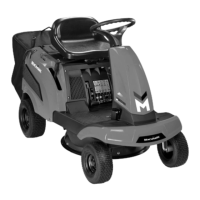10
Explosion!
1. Supply petrol before starting the engine. Do not remove the tank cap and do not
supply petrol while the engine is running or hot.
2. Should the petrol run over, do not attempt to start the engine, but move the
machine well away from the spot where you spilled the petrol. Avoid any cause of
spark or fire until the petrol fumes have completely disappeared.
3. Close back the petrol tank and the containers by safely tightening their caps.
4. Replace the muffler if it is faulty or damaged.
5. Before use, always visually check that the blade, the blade fastening screws, and
the cutters are not worn or damaged. Replace any damaged or worn blades, as
well as their fastening screws in correct series to maintain proper balancing.
Repairs and maintenance of mechanical parts must be done by an authorized
service center.
RULES FOR CORRECT OPERATION
Do not operate the engine in a conned or restricted area where
the dangerous carbon monoxide contained in the exhaust fumes may build up.
1. Only operate on grounds that are lit by daylight or by adequate artificial lighting.
2. Before starting the engine, disengage the blade, place the gear shift in neutral “N”
and engage the parking brake.
3. Avoid using the lawn mower on wet grass as much as possible.
4. Do not operate on excessively steep slopes. Check the limits indicated in the
operator’s manual.
Risk of overturning on steep gradients.
1. Do not use the machine on lawns with longitudinal gradients of more than 25%
(14°).
2. Do not use the machine on lawns with slight side gradients above 15% (8°).
Remember, there is no such thing as a “safe” gradient. Moving on sloped lawns requires
special care and experience.
SLOPE SPECIFICS
Slopes are a major factor related to accidents. Operation on slopes requires extra
caution.

